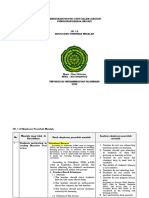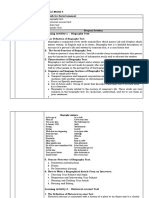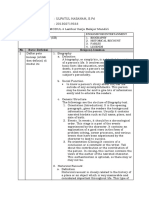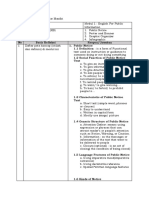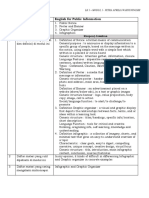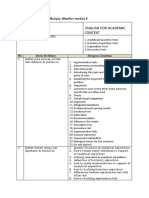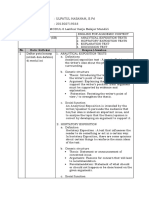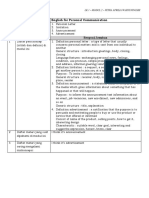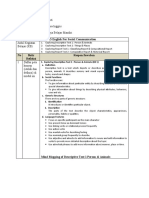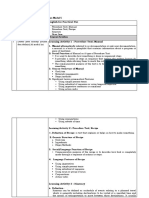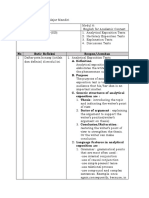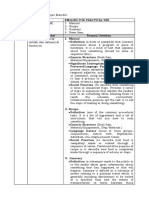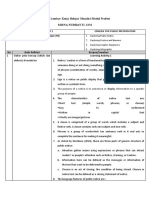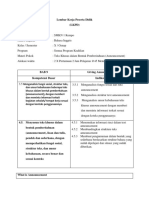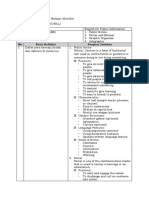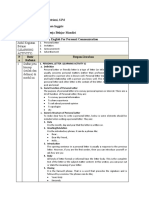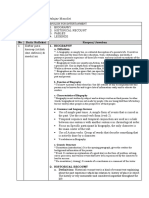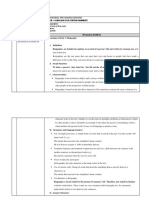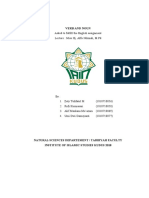LK Modul 4 English For Entertainment
Uploaded by
Sari FebriantiLK Modul 4 English For Entertainment
Uploaded by
Sari FebriantiNama : Sari Febrianti
Kelas : BI-01 Bahasa Inggris
LK 4 : Lembar Kerja Belajar Mandiri
Judul Modul Modul 4 English For Entertainment
Judul Kegiatan 1. Biography
Belajar (KB) 2. Historical Recount
3. Fables
4. Legends
N Butir Respon/Jawaban
o Refleksi
1 Daftar peta 1. BIOGRAPHY (KB 1)
konsep a. Definition
(istilah dan Biography is detailed description of person’s life both the past and present.
Biographical works are usually non-fiction, but fiction can also be used to portray a
definisi) di person's life.
modul ini b. Social Function
To know a person’s story about his / her life outside of any accomplishments
this person may be known for and to give lots of information easily and to
educate the readers.
To entertain the readers .
c. Characteristics
Biography is not written by subject, itis always written in third person.
Based on the fact that a character's life experience contains the story or history
of a character in his or her life.
It describes the person's surroundings (where, when and how the person lived)
Clear language must really be applied in a biographical text to avoid mistakes in
the information presented.
d. Generic Structure
There are three parts of generic structure of biography:
1. Orientation (Introduction)
It is the opening paragraph, gives the readers the background information of the
person. Usually contains narrated biodata such as full name, place and date of
birth.
2. Events
A chronological order. This stage is part of the events or events experienced by
the character. It contains an explanation of a good story in the form of problem
solving, career processes, and various events that have been experienced by the
character to lead to success.
3. Re-Orientation (Closing)
It consists of a conclusion or a comment or the writer. Tell about the
contribution or the contribution of the person.
e. Language Features
Use of simple past tense and in chronological order
The events that told in biography are occurred in the past and definitely in
chronological order.
Temporal sequence and temporal conjunction are used as a link between
one sentence with another sentence in chronological order.
Focus on Specific participant
The only character is the main center of the text.
Use of Action verbs
Group of words that describe something that is actively done by a character.
Vocabularies in Biography
Biography is closely related to the journey of someone’s life. Therefore, you
should be familiar with the words below.
Biography
sentences
At the age of As a child
When he A few years later
Two years later The following year
In January 1996 Sadly
During Unfortunately
Biography
sentences
During Luckily
While this was happening As he grew older
From that time Although
However Often he
Eventually Later
Many times Early in 2009
Many months later Soon afterwards
He will be most remembered for In her final years
Finally Several months passed
At that time Her dedication to
Years passed before After dedication to
Shortly before For several years
Mind Mapping of Biography
2. HISTORICAL RECOUNT (KB 2)
a. Definition
is closely related to the history of a place or an object which is very memorable
and considered important throughout life. Explaining about when, where and
how it was invented and surely about the person who found it.
b. Generic Structure
The structure parts of historical recount are:
1. Orientation (Introduction)
In this paragraph, you should include the opening paragraph introducing the
participant, setting of time, as well as setting of place.
2. Events
In events, you must be aware that it should be a chronological order. This
stage is part of the events experienced by the characters. It contains a series
of events so that it constructs a complete historical series.
3. Re-Orientation (Closing)
It consists of a conclusion or a comment or sums up of evaluation made by
the writer.
c. Social / Language Function
To describe past historical experiences by retelling chronological events by
involving the important dates, characters as well as the place of the events.
To perform all-interpretive aspects in the historical recount to be able to
compile historical synthesis based on the existence of careful research
through the selection of historical facts.
To either inform or entertain the readers.
d. Language Features
The participant of historical recount must be specific, it could involve
persons, animals or things).
The of use correct pronouns referring to the participants of the text.
It deals with the use of material processes or actions verbs.
It uses some adverb phrased to mention location, manner, and frequency,
such as in the afternoon, carefully, and never.
It used the past tense in the sentences because historical recount tells the
readers about past events,
It also requires the use of adjectives to describe the objects.
The use of evaluative words are absolutely needed to assess the
significance of something,
The historical recount should be focusing on the ordered events which
were signaled by the use of time connections like after that, ,after, before,
finally, etc.,
Based on the fact, based on the real situation of the events occurred.
Mind Mapping of Historical Recount
3. FABLES (KB 3)
a. Definition
A fable is a story featuring animals, plants or forces of nature which are
anthropomorphized (given human qualities). A fable always ends with a moral
value which was intended as the lesson. This is the lesson that is intended to be
learnt through reading the story.
The difference between fable and narrative text is Fables are stories intended
to teach a lesson, and animals often speak and act like human beings. While the
characters of narrative are human beings.
b. Characteristics of Fable
Using at least one character makes a bad decision
Using simple plot and character
Involving a character who is sly or clever
Making animals or objects seem like real people, with real feelings and
emotions
Containing a moral or lesson which can be found in the end of the story
Using personification (aanthropomorphized) where Non- human characters
can talk or show human characters
Containing a funny and amusing story
Reflecting cultural beliefs
c. Social/Language Function
To entertain or to amuse the readers about the interesting story
To convey moral messages or lessons to the readers, especially for children
to behave morally in the world to understand the values of the culture in
which they are written.
d. Generic Structure
The structure parts of fables are:
1. Orientation (Introduction)
This is the introduction of what is inside the text. It tells about hat text talks
in general, who involves in the text, when and where it happens.
2. Complication
It tells what happens with the participants. It explores the conflict among
the participants.
3. Resolution
This phase tells how the participants solve the problems aroused by the
conflict.
e. Social/Language Function
To entertain or to amuse the readers about the interesting story
To convey moral messages or lessons to the readers, especially for children
to behave morally in the world to understand the values of the culture in
which they are written.
f. Language Features
There are some language features that should be considered when read or
create a type of fable:
Using common and nonspecific setting
Often taking place outside
Using past action verb: Climbed, Turned, Brought
Using specific noun as pronoun of person, animal in the story. Example:
The king, the queen, etc.
Using adjectives which are for noun phrase. Example: Long black, hair, two
red apples, etc.
Using time connectives and Conjunctions to arrange the events. Examples:
Then, before, after, soon, etc.
Using adverbs and adverbial phrase to show the location of events.
Examples: here, in the mountain, ever after, etc.
Using dialogue to elicit an emotional response from the reader.
Using Past Tense
Ending in happy resolution.
Using of variety of simple, compound and complex sentences.
g. Moral values of the fable
A fable is indeed identical with moral values, below are some examples of
moral value of the fables:
Persuasion is better than force
Liars may give themselves away
Make hay while the sun shines
Don’t just follow the crowd
Pride can be costly
Mind Mapping of Fable
4. LEGENDS (KB 4)
a. Definition
A legend is a narrative that focuses on a historically or geographically specific
figure, and describes his/her exploits. Similar to a myth, a legend can provide
an etymological narrative, often filling in historical gaps.
The differences between a legend and a myth. While legends are made up
stories, myths are stories that answer questions about the working of natural
phenomenon.
b. Social/Language Function
To present the story of human actions in such a way that they are perceived
by the the listeners or readers to be true (in literature).
To entertain or to amuse the readers about the interesting story (in
general)
c. Characteristics of Legends
A legend is a set in specific place or time
The main character is often heroic
The main character is a human, not a God
A legend is a fictional story
Usually there is some historical truth at the heart of every legend
Heroes perform great deeds with their strength and their intelligence.
Exaggeration is usually involved in retelling deeds.
Heroes often give up dreams of happiness to help others
The hero is real but some parts of the story are not completely true. They
have been stretched or expanded upon.
Handed down through generation
The story was told orally and turned into literary masterpieces
d. Generic Structure
1. Orientation (Introduction)
This is the introduction of what is inside the text. It tells about the text talks
in general, who involves in the text, when and where it happens. It should
include the characters of the story.
2. Complication
It tells what happens with the participants. It explores the conflict among
the participants.
3. Resolution
This phase tells how the participants solve the problems aroused by the
conflict.
4. Re-Orientation
It tells the conclusion of the story. It usually include the lesson from
the story.
e. Language Features
There are some language features that should be considered when you read
or create a type of a legend:
The use of Adjective that form the noun phrase. Example: the strong
crocodile
Time connectives and conjunction. Example: A long time ago
The use of adverb and adverbial phrases to indicate the location of the
incident or events. Example: In the river
The use of action verbs in the past tense. Example: They curved her.
People then always talked
The used of saying verbs that mark remarks. Example : He said angrily
The use of thinking verbs that mark the thoughts, perceptions or feelings
of the characters in the story. Example: The man then looked so curious.
The use of dialogue to elicit an emotional response from the reader
Mind Mapping of Legend
2 Daftar The meaning of dialogue to elicit an emotional response from the reader
materi and its examples.
yang sulit
dipahami
di modul
ini
3 Daftar Distinguishing between legend and myth.
materi
yang
sering
mengalami
miskonsep
si
You might also like
- Anglia Pre Intermediate and IntermediateNo ratings yetAnglia Pre Intermediate and Intermediate11 pages
- LK 1 - Modul 4 English For Entertainment - 201506473786 Syamsul Bahri100% (4)LK 1 - Modul 4 English For Entertainment - 201506473786 Syamsul Bahri6 pages
- LK 1 PROFESIONAL MODUL 4 Lembar Kerja Belajar Mandiri100% (3)LK 1 PROFESIONAL MODUL 4 Lembar Kerja Belajar Mandiri4 pages
- LK 1 - Profesional - Bahasa Inggris - Modul 1100% (2)LK 1 - Profesional - Bahasa Inggris - Modul 15 pages
- LK 1 - Profesional - Bahasa Inggris - Modul 2100% (1)LK 1 - Profesional - Bahasa Inggris - Modul 23 pages
- Nur Annisa MR - LK - 1.modul 1 Profesi - Bahasa InggrisNo ratings yetNur Annisa MR - LK - 1.modul 1 Profesi - Bahasa Inggris4 pages
- Peta Konsep Modul 1 Profesional Bahasa Inggris100% (13)Peta Konsep Modul 1 Profesional Bahasa Inggris1 page
- LK 1-Profesional - Bahasa Inggris - Modul 467% (3)LK 1-Profesional - Bahasa Inggris - Modul 46 pages
- Nur Annisa MR - LK - 1.modul 4 Profesi - Bahasa Inggris100% (1)Nur Annisa MR - LK - 1.modul 4 Profesi - Bahasa Inggris5 pages
- Nur Annisa MR - LK - 1.modul 5 Profesi - Bahasa InggrisNo ratings yetNur Annisa MR - LK - 1.modul 5 Profesi - Bahasa Inggris4 pages
- LK 2 Modul 5 English For Practical Use - Dwi Kurniawan100% (1)LK 2 Modul 5 English For Practical Use - Dwi Kurniawan2 pages
- English For Academic Context: LK 1: Lembar Kerja Belajar Mandiri Modul 6100% (1)English For Academic Context: LK 1: Lembar Kerja Belajar Mandiri Modul 62 pages
- LK 1: Lembar Kerja Belajar Mandiri: English For Personal CommunicationNo ratings yetLK 1: Lembar Kerja Belajar Mandiri: English For Personal Communication2 pages
- LK 1: Lembar Kerja Belajar Mandiri: Nama: Medi Heri Saputra Kelas: 001 Bahasa Inggris Modul: 5 (Profesional)100% (1)LK 1: Lembar Kerja Belajar Mandiri: Nama: Medi Heri Saputra Kelas: 001 Bahasa Inggris Modul: 5 (Profesional)1 page
- LK 1 PROFESIONAL MODUL 6 Lembar Kerja Belajar Mandiri100% (2)LK 1 PROFESIONAL MODUL 6 Lembar Kerja Belajar Mandiri3 pages
- LK 1 - Modul 3 English For Social Communication - 201506473786 Syamsul BahriNo ratings yetLK 1 - Modul 3 English For Social Communication - 201506473786 Syamsul Bahri5 pages
- Peta Konsep Modul 2 Profesional Bahasa Inggris100% (7)Peta Konsep Modul 2 Profesional Bahasa Inggris1 page
- LK 1 PROFESIONAL MODUL 2 Lembar Kerja Belajar MandiriNo ratings yetLK 1 PROFESIONAL MODUL 2 Lembar Kerja Belajar Mandiri3 pages
- LK 1 PROFESIONAL MODUL 3 Lembar Kerja Belajar Mandiri100% (2)LK 1 PROFESIONAL MODUL 3 Lembar Kerja Belajar Mandiri2 pages
- Nur Annisa MR - LK - 1.modul 6 Profesi - Bahasa InggrisNo ratings yetNur Annisa MR - LK - 1.modul 6 Profesi - Bahasa Inggris5 pages
- LK Modul 3 English For Social CommunicationNo ratings yetLK Modul 3 English For Social Communication6 pages
- LK 1 - Modul 5 English For Practical Use - 201506473786 Syamsul Bahri100% (3)LK 1 - Modul 5 English For Practical Use - 201506473786 Syamsul Bahri5 pages
- Nur Annisa MR - LK - 1.modul 3 Profesi - Bahasa InggrisNo ratings yetNur Annisa MR - LK - 1.modul 3 Profesi - Bahasa Inggris4 pages
- LK 1-Profesional - Bahasa Inggris - Modul 3No ratings yetLK 1-Profesional - Bahasa Inggris - Modul 35 pages
- LK 1: Lembar Kerja Belajar Mandiri: English For Practical UseNo ratings yetLK 1: Lembar Kerja Belajar Mandiri: English For Practical Use2 pages
- Utin Nur'aini - LK 1.1 - Modul 3 English For Social Communication100% (1)Utin Nur'aini - LK 1.1 - Modul 3 English For Social Communication3 pages
- LK 1: Lembar Kerja Belajar Mandiri: No Butir Refleksi Respon/JawabanNo ratings yetLK 1: Lembar Kerja Belajar Mandiri: No Butir Refleksi Respon/Jawaban2 pages
- LK.1.1 Modul 1-6 (Profesi) - Misna Nurbayti100% (1)LK.1.1 Modul 1-6 (Profesi) - Misna Nurbayti31 pages
- LK 1 Profesional Modul 5 Lembar Kerja Belajar MandiriNo ratings yetLK 1 Profesional Modul 5 Lembar Kerja Belajar Mandiri4 pages
- Bahan Ajar Descriptive Text Miftakhul Khasan100% (1)Bahan Ajar Descriptive Text Miftakhul Khasan6 pages
- LK 1 Modul I English For Public InformationNo ratings yetLK 1 Modul I English For Public Information4 pages
- LK 1 - Profesional English For Personal CommunicationNo ratings yetLK 1 - Profesional English For Personal Communication3 pages
- LK 1.1: Lembar Kerja Belajar Mandiri (Modul 1 - Profesional)No ratings yetLK 1.1: Lembar Kerja Belajar Mandiri (Modul 1 - Profesional)4 pages
- LK. 1.2 Eksplorasi Penyebab Masalah-DIAN KESUMAWATI100% (1)LK. 1.2 Eksplorasi Penyebab Masalah-DIAN KESUMAWATI10 pages
- LK Modul 2 English For Personal CommunicationNo ratings yetLK Modul 2 English For Personal Communication7 pages
- LK 1.1: Lembar Kerja Belajar Mandiri (Modul 5 - Profesional)100% (1)LK 1.1: Lembar Kerja Belajar Mandiri (Modul 5 - Profesional)5 pages
- LK Modul English For Entertaiment Modul 4No ratings yetLK Modul English For Entertaiment Modul 46 pages
- B. He Was Afraid of People's Reactions: I. ListeningNo ratings yetB. He Was Afraid of People's Reactions: I. Listening18 pages
- English Language Attitude Among Filipino Prospective Language Teachers: An Analysis Through The Mentalist Theoretical LensNo ratings yetEnglish Language Attitude Among Filipino Prospective Language Teachers: An Analysis Through The Mentalist Theoretical Lens19 pages
- The Atlas of North American English Phonetics Phon... - (Part D Overviews of North American Dialects) - 1No ratings yetThe Atlas of North American English Phonetics Phon... - (Part D Overviews of North American Dialects) - 168 pages
- Change The Verbs Below Into The Past Tense and Put Them Into The Correct Place in The Sentences0% (1)Change The Verbs Below Into The Past Tense and Put Them Into The Correct Place in The Sentences5 pages
- Alberta Language Environnement Questionnaire ALEQ-4No ratings yetAlberta Language Environnement Questionnaire ALEQ-47 pages
- Microsoft PowerPoint - Thieu Nang - Session 9No ratings yetMicrosoft PowerPoint - Thieu Nang - Session 944 pages
- English Communication Skills III Level3 2021No ratings yetEnglish Communication Skills III Level3 202158 pages
- Verb and Noun: Asked To Fulfill The English Assignment Lecture: Miss Hj. Alfu Nikmah, M.PDNo ratings yetVerb and Noun: Asked To Fulfill The English Assignment Lecture: Miss Hj. Alfu Nikmah, M.PD8 pages
- Class 5 Compiled Syllabus and QP 2023 24No ratings yetClass 5 Compiled Syllabus and QP 2023 2410 pages

